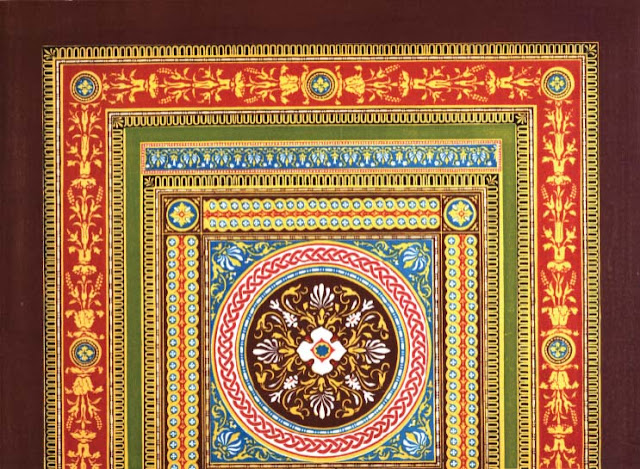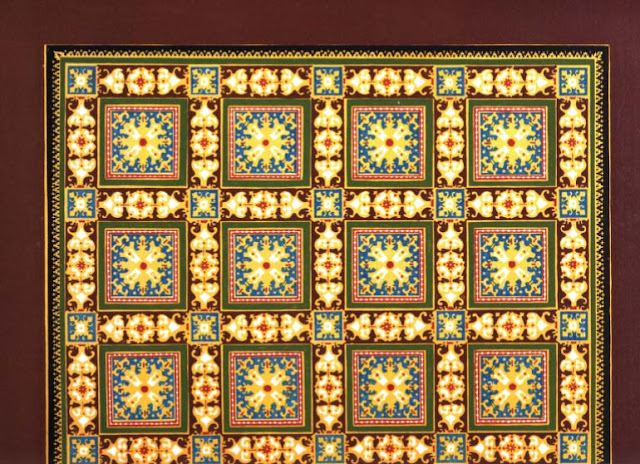Illustration: Minton and Co. Ceramic Floor Design, 1851.
The Gothic Revival period of the mid-nineteenth century onwards can sometimes seem all-pervasive and it is therefore standard to see all companies supplying the interiors market with a preponderance of medieval inspired decorative work. However, as with all things, nothing is ever quite as neat, tidy and simple as some would perhaps prefer.
As with any period of the decorative arts, despite the fact that many are swept along within the framework of fashion and contemporary style often dictated by self-proclaimed arbiters of taste, much also depends on the more intimate and individual critique of personal taste and the perception and projection of the uniqueness of the individual. Of course, much also depends on actual and perceived status and in this respect companies that supplied the decorative official state and private domestic market were more than willing to cater.
Minton and Co which is a company very much associated with the Gothic Revival, they did after all produce ceramic tile work supplied by the designer who most saw as being if not the originator of the movement, then at least one of its most vociferous champions, Augustus Welby Northmore Pugin. However, the company also produced decorative work that could only be described as being within the classical mould.
The two examples illustrating this article were published in 1851 and show plans for ceramic floor designs that are entirely classically motivated. Interestingly, they were shown within a publication alongside their more easily recognised medieval styled work. Although much has been said of the 'Battle of the Styles,' the famous arrangement whereby classical derived architecture and decoration was firmly locked in a bitter and often acrimonious public debate, some would say battle to the death, with medieval derived architecture and decoration, it was perhaps not all that it might have seemed, at least to many of the companies that supplied decorative to both sides of the argument. It seems sometimes as if the posturing was a little magnified, a little over-blown and certainly fuelled by those who had most to gain or lose in the public argument. Companies such as Minton and Co could not afford to alienate customers, potential or otherwise and therefore took the pragmatic option of supplying both camps with the best decorative work they could offer.
Illustration: Minton and Co. Ceramic floor design, 1851.
It is sometimes a mistake to think that a particularly pervasive and instantly recognisable decorative style such as that of the Gothic Revival was equally all-pervasive in the market place and this can never be fully true. Although historically it makes more logical and orderly sense to place one style after another, the reality makes much less sense. Some of the debate and personal choice between classical and gothic has undoubtedly to do with perception. The classical was very much associated with the rural living aristocracy, whilst the gothic was equally associated with the new middle class and the rise of urban living. However, some of the old aristocracy took the gothic to heart and a percentage of the new middle class tried to ape their perceived betters by building in the classical.
Either way, Minton and Co produced a couple of decorative floor designs that were probably some of the best work available during the 1850s. The colours are crisp and the decoration itself, whilst involved, is relatively quiet and contained. They are perhaps in many respects all that was expected of a classically inspired decorative interior. They may well not have been entirely correct in their exactitude and certainly during this period leeway was given to a sometimes creative approach to both the classical and medieval. However, Minton and Co were one of the better companies and had a relatively high status in both finished product and development of creative ideas.
As an interesting side issue concerning the animosity between classical and medieval inspirations, there have been a number of articles written concerning the difference in the outward projection of governments depending on whether they inhabit buildings that are classical, gothic or otherwise. Some have even suggested that Britain may well have seen its own projection slightly differently if it had had a classically inspired Houses of Parliament rather a gothic. Although this can never really be proved one way or the other it is a fascinating insight into perhaps the effect architecture and decoration can have on a nation or at least its outward projection, as well as its own self-belief.
Further reading links:

















